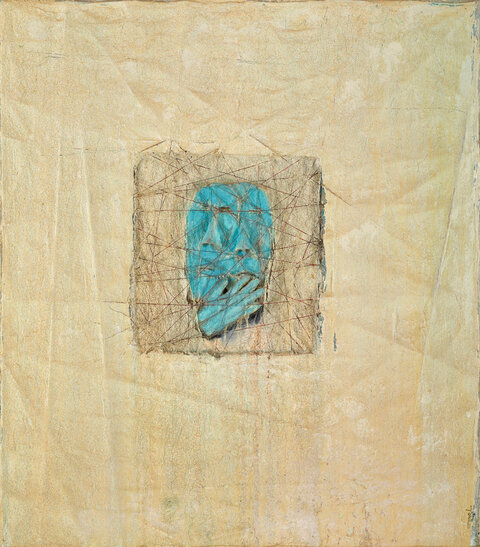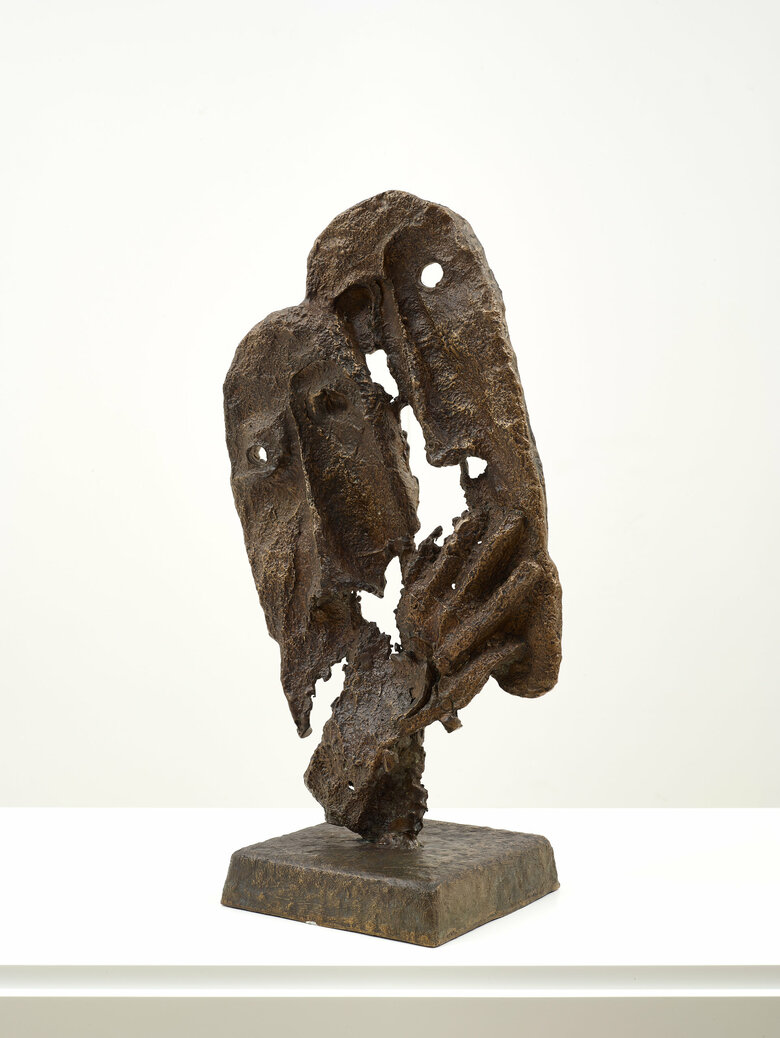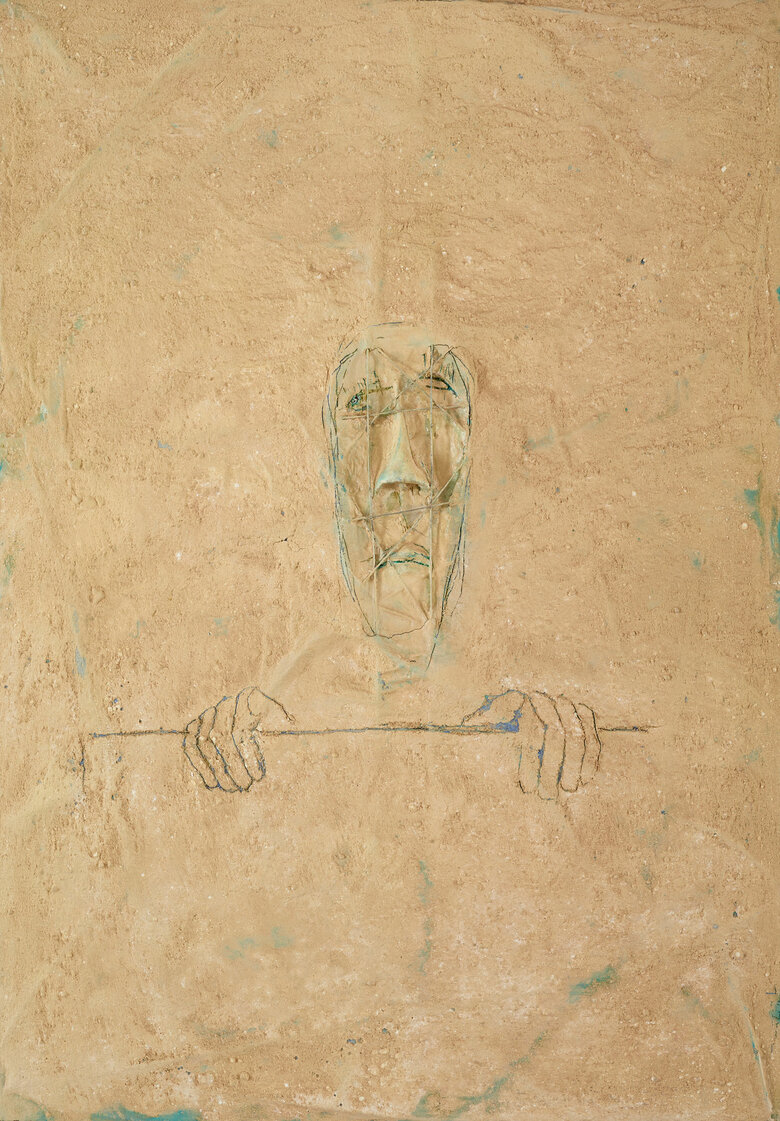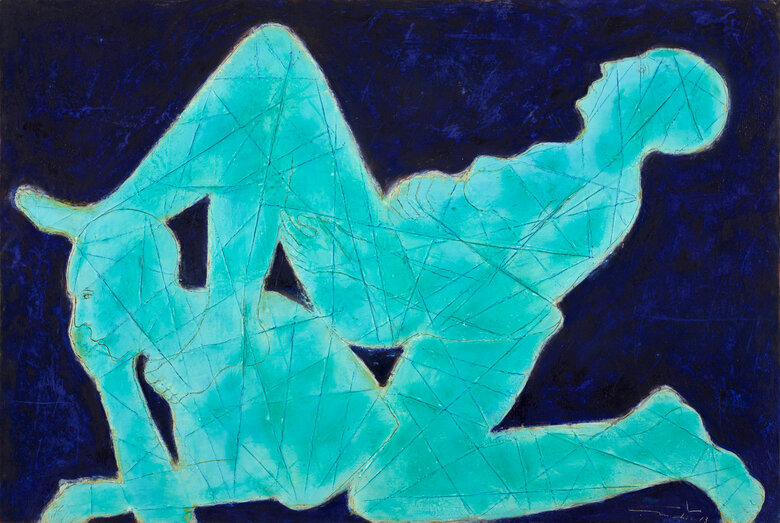Untitled (2012), created by Moroccan artist Mahi Binebine, is an abstract artwork executed with plaster paper on a wood panel awash with beige and light brown pigments. The work evokes a sand-like appearance with a textured finish that suggests a desert's rough, uneven terrains. Amidst this desolate background, two overlapping faces, created in relief and painted in striking turquoise blue, rest within a central square frame; they are reminiscent of African tribal masks with elongated faces, pronounced noses, and hollow, narrow eyes. The choice of turquoise blue juxtaposed against the hues of beige and brown creates a vivid visual contrast, making the heads stand out prominently and emphasizing their focal point in the artwork.
The two faces seem trapped and pressed for space, with the left one partially obscuring the right. Further emphasizing this sense of restriction, the right face's mouth is conspicuously covered by a detached hand, while the left one’s mouth remains firmly shut. This sense of entrapment is accentuated by the rustic metal-like and erratic lines crisscrossing the square frame.
Binebine's painting is a profound metaphorical depiction of imprisonment. The artist communicates his perspective on the constrained and restricted existence of the individuals portrayed. The masked faces, in turquoise blue—a color often associated with depth, sadness, and introspection—disturbingly symbolize the physical and psychological trials of incarceration. They serve as a poignant contrast to the desert backdrop and evoke a deep sense of isolation from the outside world. Their inability to voice their plight is underscored by the covered mouth, further emphasizing the stifled existence of the imprisoned.
These faces suggest a duality: a tug-of-war between the silence and the urge to vocalize or between captivity and the yearning for freedom. Enhancing this narrative, the painting's background, reminiscent of a barren desert's topology, draws a chilling parallel to the grim environment of the notorious Tazmamart prison camp 1, a secret prison located in the Atlas Mountains of Morocco.
Notes:
1 Tazmamart is a secret prison located in the Atlas Mountains of Morocco. Established in 1972 following a failed coup against King Hassan II, the prison was designed to incarcerate and silence the regime's perceived enemies. Many former army officers and inmates endured extreme conditions, confined to underground cells deprived of light and human contact. They grappled with minimal sustenance, exposure to extreme temperatures, lack of medical care, and the psychological trauma of isolation. Eyewitness accounts from survivors, released in 1991, evoke haunting images of medieval-era imprisonment. Tazmamart was finally closed in 1991.
Much like the narratives within his literary collection, Binebine's art is deeply personal and reflective of his own experiences. The imagery of confinement and isolation within this work echoes the harrowing experiences of his brother, Aziz, during his incarceration in Tazmamart. 2 . Beyond the bounds of this specific piece, Binebine's artistic oeuvre not only illuminates his profound empathy for those caught in the oppressive snares of societal, economic, or intellectual confines, but also reflects the critical socio-political challenges in Morocco by addressing concerns such as political detainment.3 A recurring motif across his recent works is an undeniable yearning for emancipation.
The figures he paints are often tragically encased within restrictive boundaries as they battle for their freedom. Through his evocative pieces, particularly Untitled (2012), Binebine invites viewers to empathize and reflect upon the complexities of human endurance.
2 Bou Hreid, Mohammad. “ماحي بينبين: أخي خرج من معتقل تازمامارت وأنا ما زلت داخله.” مغرس, October 29, 2008.
https://www.maghress.com
3 Al Khasar , Abed El Rahman. “التشكيلي المغربي ماحي بينبين يسائل الزمن في ‘أفق مائل.’” اندبندنت عربية, January 18, 2021.
https://www.independentarabia
Signed in Arabic and dated "2012" on the lower left front










